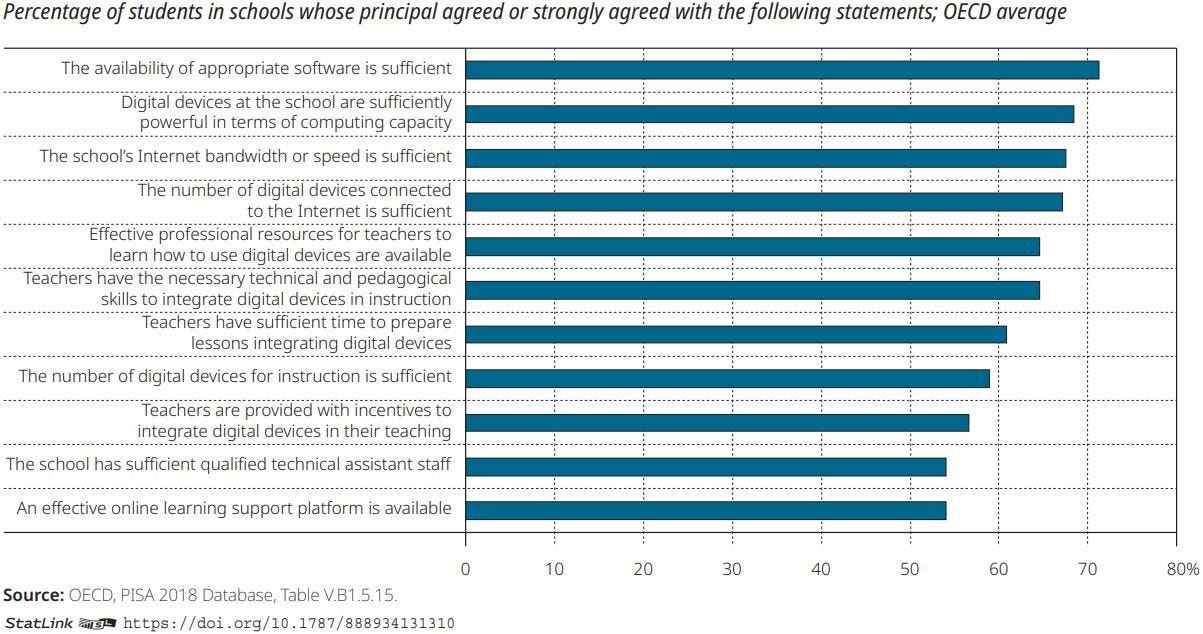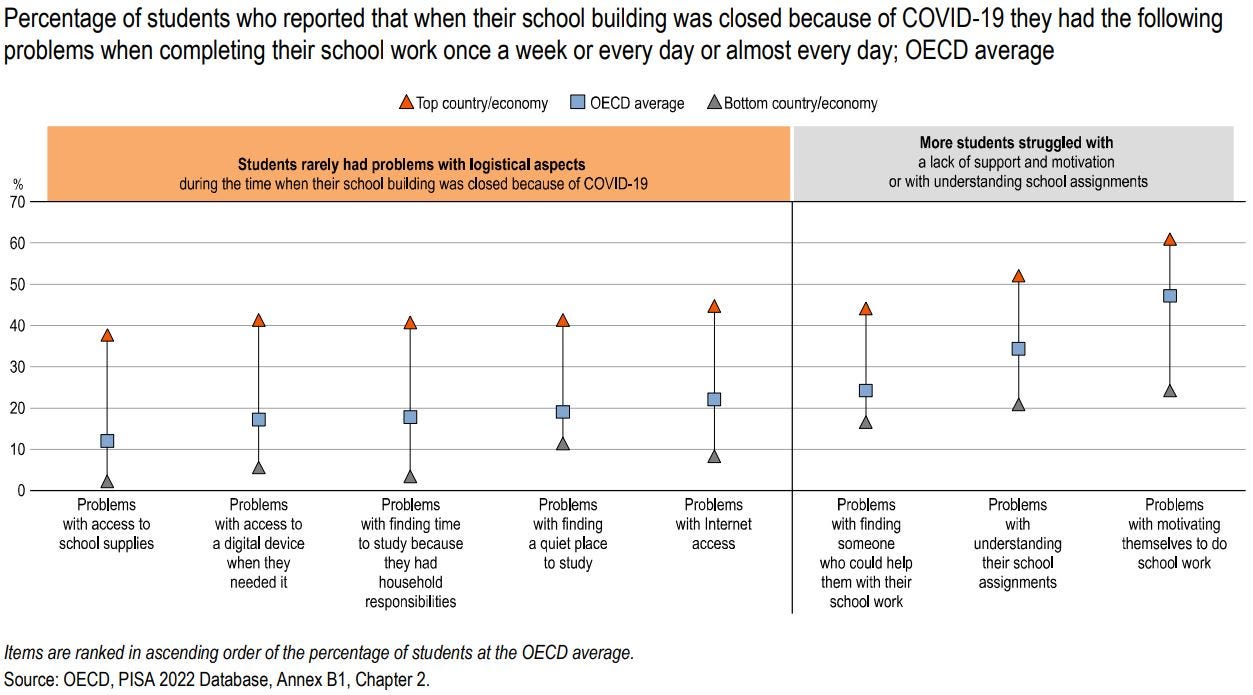Ensuring universal access to digital hardware (such as laptops), software (like learning platforms), and high-quality broadband is essential for fostering equity and inclusion in education. Despite progress in narrowing this gap in recent years, with nearly all students across OECD countries having some form of internet access at home, education systems continue to encounter various barriers. These include challenges related to geographic distance, such as equipping rural areas with broadband, as well as insufficient equipment in schools and socioeconomic disparities.
Digital divide in education
The digital divide signifies unequal access to digital technologies, particularly concerning internet connectivity and device availability, alongside disparities in infrastructure, skills and affordability. These gaps result in unequal opportunities for information access and digital participation.

Key messages
Another feature of the digital divide refers to differences in digital skills, uses and motivations. Digital skills are necessary for learners to harness the opportunities of the digital environment and to ensure that all young people are digitally included. While today’s students may have more exposure to digital technologies from younger ages, it cannot be assumed that they have the necessary digital skills to use technology effectively. Education systems and other actors, such as parents, play important roles in supporting digital skill development in children.
Another element of the digital divide extends to the differences in offline outcomes based on engagement with digital technologies, such as material or social aspects. The inability to make the most of digital opportunities can magnify existing offline inequalities. Education systems need to consider how to equip individuals with requisite resources to use their digital skills in ways that can bring about tangible beneficial outcomes, whether this concerns education or work, health or other areas more broadly.
Context
Socio-economically advantaged schools are better prepared for digital learning.
School capacity to enhance teaching and learning using digital devices is greater in socio-economically advantaged schools than disadvantaged schools. On average across OECD countries, in 10 out of the 11 indicators, students in advantaged schools were more likely to attend a school whose principal agreed that the school’s capacity to use digital devices is sufficient.
Schools’ capacity to enhance teaching and learning using digital devices (2018)

How students benefit from digital access varies
The COVID-19 pandemic highlighted digital divides. During periods of remote learning due to school closures, students reported various problems relating to their ability to learn online. While students across the OECD are generally well-equipped for learning, with around 3 in 4 students reporting to have sufficient access to digital devices and the internet when needed, many students struggled with motivating themselves to do schoolwork or with understanding school assignments.
Problems with remote learning (2022)

Related publications
-
 26 October 2023
26 October 2023
Programmes and projects
-
Education for Inclusive Societies Project is designed to respond to the increasing diversity that characterises education systems, and seeks to help governments and relevant stakeholders achieve more equitable and inclusive education systems as a pillar to create more inclusive societies.Learn more
-
PISA is the OECD's Programme for International Student Assessment. PISA measures 15-year-olds’ ability to use their reading, mathematics and science knowledge and skills to meet real-life challenges.Learn more
-
Understanding the nature of 21st Century childhood is crucial for an education that is increasingly expected to support students to thrive in both a digital and non-digital world, delivering academic learning while also building physical and emotional well-being. This has implications for the skills, capacity and resources required.Learn more
-
Artificial Intelligence (AI) and robotics are becoming increasingly sophisticated at replicating human skills. The evolution of these technologies could fundamentally transform work over coming decades and deeply affect education’s current role in providing skills and preparing learners for future work.Learn more
-
The OECD Career Readiness project is designed to provide new advice to governments, schools, employers and other stakeholders on how to best prepare young people to compete in an ever-changing labour market.Learn more
-
The Education Policy Outlook is an analytical observatory that monitors the evolution of policy priorities and policy developments from early childhood education to adult education, mainly among OECD education systems, to provide a comparative understanding of how policies are evolving, and how they can be best implemented or improved over time.Learn more
-
The OECD’s programme on education and skills policy support policymakers in their efforts to achieve high-quality lifelong learning, which in turn contributes to personal development, sustainable economic growth, and social cohesion.Learn more
-
OECD Future of Education and Skills 2030 aims to build a common understanding of the knowledge, skills, attitudes and values students need in the 21st century.Learn more
-
The OECD Indicators of Education Systems (INES) programme seeks to gauge the performance of national education systems through internationally comparable data.Learn more
-
The Survey of Adult Skills, a product of the PIAAC, measures adults’ proficiency in literacy, numeracy and the ability to solve problems in technology-rich environments.Learn more
-
Since 2013, the OECD has gathered evidence on how school resource policies work in different contexts. The focus is now on digital resources to enable countries to learn from each other in the digital transformation of their education.Learn more
-
Data and digital technologies are among the most powerful drivers of innovation in education, offering a broad range of opportunities for system and school management, as well as for teaching and learning. But they also create new policy issues as countries face challenges to reap the benefits of digitalisation in education while minimising its risks.Learn more
-
TALIS - the Teaching and Learning International Survey - is the world's largest international survey about teachers and school leaders.Learn more
-
Preparing for the future means taking a careful look at how the world is changing. Reflecting on alternative futures helps anticipate and strategically plan for potential shocks and surprises.Learn more






